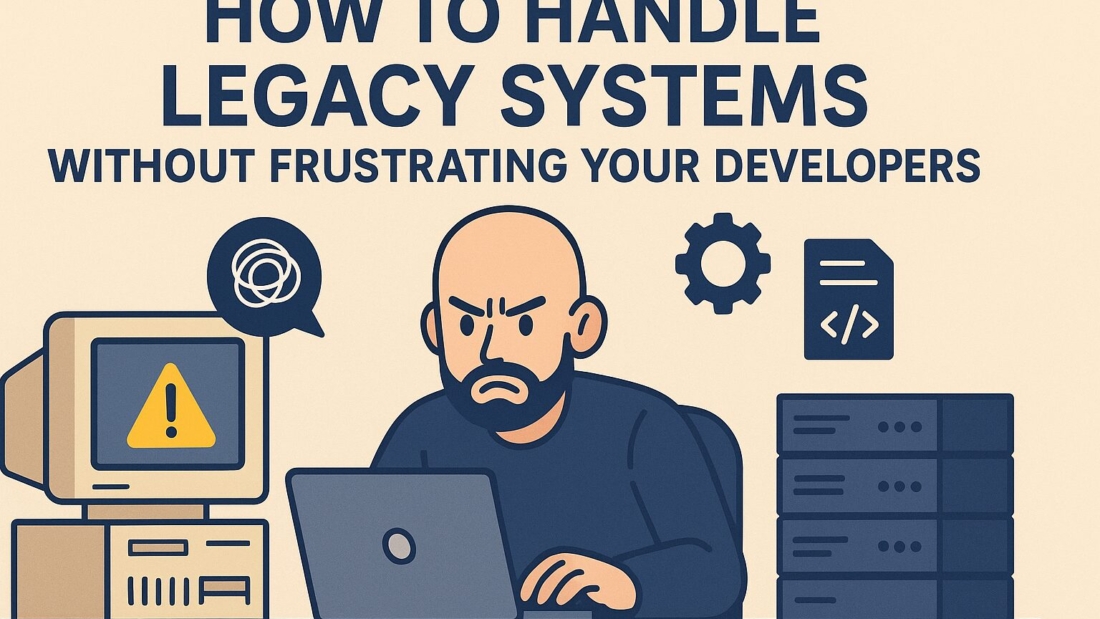Every technology-driven business eventually faces the same challenge: legacy systems. These outdated platforms and applications may still keep critical operations running, but they often create bottlenecks, limit scalability, and frustrate developers tasked with maintaining them.
While it might be tempting to scrap everything and start fresh, the reality is that legacy systems can’t always be replaced overnight. They’re often deeply integrated into business processes, expensive to upgrade, and essential for daily operations.
So how do you manage legacy systems effectively—without burning out your developers? The answer lies in balance: modernizing strategically while making life easier for your team.
1. Recognize the Hidden Costs of Legacy Systems
Legacy systems aren’t just “old software”—they carry hidden costs. Developers waste countless hours troubleshooting brittle code, documenting unclear dependencies, or working around missing integrations. This leads to:
Reduced productivity – Valuable time is spent maintaining instead of innovating.
Lower morale – Developers feel stuck maintaining “antique code.”
Increased risk – Security vulnerabilities and downtime become more frequent.
Acknowledging these pain points is the first step to building empathy and avoiding frustration. Developers need to know that management understands the strain legacy systems create.
2. Invest in Documentation and Knowledge Sharing
One of the biggest developer complaints about legacy systems is poor or missing documentation. Without it, onboarding new team members becomes slow and existing developers spend unnecessary time “reverse engineering” the system.
To fix this:
Create clear documentation that explains system architecture, dependencies, and business logic.
Encourage knowledge-sharing sessions where senior developers explain system quirks.
Use internal wikis or tools like Confluence or Notion for ongoing documentation updates.
This effort not only reduces developer frustration but also makes future modernization smoother.
3. Prioritize Incremental Improvements Over Big Bang Rewrites
Many businesses dream of replacing legacy systems with modern solutions in one big project. But complete rewrites often fail due to scope creep, cost overruns, and unforeseen dependencies.
Instead, adopt a modular modernization approach:
Identify the most painful components.
Gradually replace or re-architect them.
Use APIs to connect old and new systems until a full migration is possible.
This approach reduces developer stress by breaking down overwhelming tasks into manageable wins, showing steady progress without requiring a massive overnight overhaul.
4. Give Developers the Right Tools
Legacy systems often frustrate developers because they lack modern tooling support. By providing better tools, you can reduce pain points and improve developer morale. For example:
Automated testing tools to catch bugs early.
Monitoring and logging systems to quickly diagnose issues.
Version control (if not already in place) to track changes safely.
Containerization (e.g., Docker) to run legacy apps in isolated environments.
Even if the system itself is outdated, better tooling helps developers work more effectively and with less stress.
5. Balance Maintenance With Innovation
One reason developers dislike legacy projects is that they feel stuck in maintenance mode without opportunities to innovate. To avoid burnout, balance maintenance tasks with meaningful projects.
Some strategies include:
Assigning developers to rotating shifts—a mix of legacy maintenance and modern projects.
Encouraging small innovation sprints, where teams can experiment with modern solutions related to the legacy system.
Recognizing and rewarding efficiency improvements (e.g., automating a legacy process).
By giving developers space for creativity, you keep morale high even when dealing with old systems.
6. Communicate the Bigger Picture
Developers often get frustrated when they don’t see the “why” behind legacy work. If they’re only told to “fix bugs” or “patch code,” it feels like meaningless grunt work.
To solve this, leaders should:
Explain the business impact of maintaining the legacy system.
Share how modernization plans will benefit the team long-term.
Celebrate milestones, even small ones, to show progress.
Transparency turns frustrating tasks into purposeful contributions.
7. Plan for Long-Term Modernization
While short-term fixes are essential, developers also want to see a clear path forward. Create a realistic modernization roadmap that outlines:
Which systems will be phased out first.
What new technologies will be introduced.
How developer input shapes the modernization process.
When developers know there’s a plan in place, they’re more motivated to keep maintaining the old system until the transition is complete.
8. Foster a Supportive Culture
Finally, handling legacy systems without frustrating developers requires a supportive culture. This means:
Acknowledging the difficulty of the work.
Providing adequate resources.
Encouraging open feedback about what’s working—and what isn’t.
Sometimes, even small gestures like recognizing developers’ efforts in team meetings can go a long way in reducing frustration.
Conclusion
Legacy systems are a reality for most businesses, but they don’t have to be a nightmare for your developers. By improving documentation, adopting incremental modernization, providing better tools, balancing maintenance with innovation, and fostering open communication, you can manage outdated technology without draining team morale.
Remember, your developers are not just maintaining old code—they’re the bridge between the past and future of your organization’s technology. Treating them with empathy and equipping them with the right support ensures that modernization is not only successful but also sustainable.

